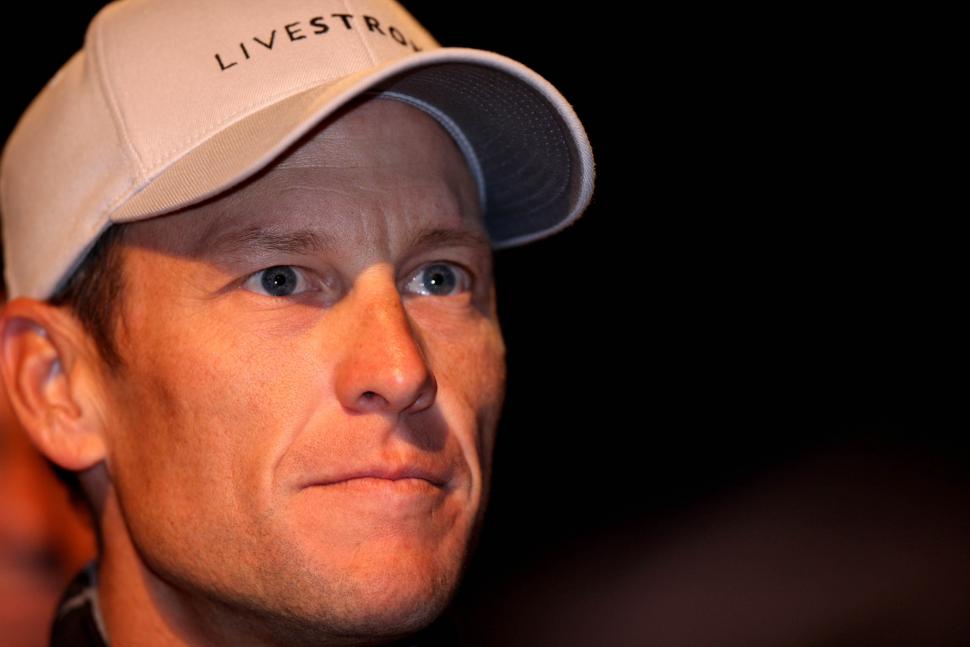- News
- Reviews
- Bikes
- Components
- Bar tape & grips
- Bottom brackets
- Brake & gear cables
- Brake & STI levers
- Brake pads & spares
- Brakes
- Cassettes & freewheels
- Chains
- Chainsets & chainrings
- Derailleurs - front
- Derailleurs - rear
- Forks
- Gear levers & shifters
- Groupsets
- Handlebars & extensions
- Headsets
- Hubs
- Inner tubes
- Pedals
- Quick releases & skewers
- Saddles
- Seatposts
- Stems
- Wheels
- Tyres
- Tubeless valves
- Accessories
- Accessories - misc
- Computer mounts
- Bags
- Bar ends
- Bike bags & cases
- Bottle cages
- Bottles
- Cameras
- Car racks
- Child seats
- Computers
- Glasses
- GPS units
- Helmets
- Lights - front
- Lights - rear
- Lights - sets
- Locks
- Mirrors
- Mudguards
- Racks
- Pumps & CO2 inflators
- Puncture kits
- Reflectives
- Smart watches
- Stands and racks
- Trailers
- Clothing
- Health, fitness and nutrition
- Tools and workshop
- Miscellaneous
- Buyers Guides
- Features
- Forum
- Recommends
- Podcast
news
 Lance Armstrong (pic courtesy Photosport International)
Lance Armstrong (pic courtesy Photosport International)UCI memo reveals Lance Armstrong failed four doping controls during 1999 Tour de France
A leaked memo from the UCI reveal that Lance Armstrong failed four doping controls during the 1999 Tour de France, not two as the United States Anti Doping Agency (USADA) claimed. The author, a UCI lawyer, says the most likely explanation is that the substance was contained in an ointment – even though Armstrong himself has admitted that a backdated prescription was fabricated to cover up his cortisone use.
A copy of the internal memo, dated January this year and written by UCI lawyer Philippe Verbiest, was obtained by Belgian newspaper Het Nieuwsblad, reports Telegraph.co.uk.
It says that Armstrong tested positive for a corticosteroid on July 4, 14, 15 and 21 during the 1999 Tour de France, the year he won the first of seven consecutive editions of the race.
USADA’s Reasoned Decision in the Armstrong case says that he tested positive on the day he won the Prologue, July 3, and again the following day. The UCI memo makes no mention of that 3 July test.
The rider, now banned from sport for life and stripped of results dating back to August 1998, was able to escape sanction by producing a backdated therapeutical use exemption from US Postal doctor Luis Garcia Del Moral for a saddle sore cream that would have contained the substance.
"Until the 1999 Tour de France there had been no testing for corticosteroids," said Verbiest in his memo.
"Riders, teams and team doctors didn’t have to bother about mentioning corticosteroids or medicines containing them at doping controls.
"This all of a sudden changed. The testing for corticosteroids was announced to the riders only a couple of days before the start of the Tour.
His conclusion was that the levels established in Armstrong’s test results were "indeed an ointment and not a prohibited systematic use."
However testimony from Armstrong’s then masseuse, Emma O’Reilly, and others claimed the saddle sore cream story was be a sham and that the rider had undergone cortisone injections, leading to the positive test.
Armstrong admitted to Oprah Winfrey during his televised confession in January that O’Reilly’s claims were true.
Latest Comments
- mark1a 2 hours 7 min ago
Still here, just showing a few signs of wear and tear. Hopefully still serviceable for some years to come.
- David9694 2 hours 10 min ago
Oxfordshire village building car crash near Witney...
- Secret_squirrel 2 hours 37 min ago
Has he fully recovered though, and will he ever?...
- Rendel Harris 2 hours 52 min ago
How can you know that you are "equally fearful" as "any female cyclist"? There is no possible way of quantifying such emotions and female cyclists...
- chrisonabike 3 hours 24 min ago
I think it would be fairer to blame the moon - as in "my client is a loony".
- Bungle_52 3 hours 47 min ago
Nice idea but Gloucestershire Constabulary are not interested as exemplified by this prvious NMOTD. Not only was there NFA for the close pass in...
- hawkinspeter 5 hours 19 min ago
I think black boxes are great for early detection of cognitive decline and/or sight problems. Someone's driving is going to become much less smooth...
- Bigtwin 5 hours 55 min ago
It's a fashion. https://guildford-dragon.com/shalford-driver-who-smashed-shalford-war-me...
- MTL Biker 6 hours 16 min ago
Robin Phans .....
Add new comment
4 comments
Ointment? c'mon, don't rub it in!!
How much longer do we have to put up with this bribe riddled cabal of crooks? Dixie Carter for UCI President! (Although she would probably prefer to remain in a sport that has more credibility than cycling).
I'm not really sure what the point of this is either. I don't think it improves the UCI credibility and nor does it absolve Armstrong. I guess we need the credible Alex Jones on the case (http://www.youtube.com/watch?v=LoUega3W3jU)

How does the author of the memo have any idea that the positive tests most likely resulted from use of a cream and not for more nefarious reasons? As the article says, Armstrong has subsequently admitted using cortisone injections and procuring a backdated TUE. Looks as if the UCI is still trying to divert any more suspicion from it for this period.